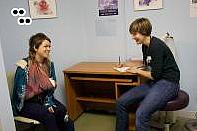Participants appreciate safety-net health access program, but note gaps
Could San Francisco have figured out a model for providing universal health care on a tight budget?
The California Endowment Health Journalism Fellowships at USC Annenberg sponsored a reporting project by Michael Stoll, along with a team of reporters at the San Francisco Public Press, to take a closer look at whether local health care reform ideas are working in one major metropolis. More than 40 individuals also donated to this project via Spot.Us. Reporting, photography and research for this project were contributed by Barbara Grady, Angela Hart, Kyung Jin Lee, Cindy Chew, Jason Winshell, Monica Jensen, Tom Guffey, Siri Markula and Frank Bass.
Part 1: Some employers drop private health plans for San Francisco's subsidized public option
Part 2: Participants appreciate safety-net health access program, but note gaps
Part 3: Medical records supporting San Francisco's universal care add millions to official cost

Healthy San Francisco participant April Fredrick, an unemployed human resource professional, values the peace of mind the program provides.
“If I have a serious health problem, knowing that I do have a doctor for treatment and prescription if I need them is the biggest benefit,” she said.
Most participants in Healthy San Francisco, the city’s 2007 initiative to expand care to more than 50,000 uninsured patients, appreciate the overall access to preventative care and treatment for chronic health conditions. A 2009 survey showed that more than nine in 10 are “very” or “somewhat” satisfied with the program. Patients cite the affordability of the program and the quality of care they receive from the health care practitioners.
“I mainly see it as emergency service,” said Alan Hyland, a 34 year-old unemployed construction worker from Nob Hill. “Health care is costly and the program is a good safety net.”
But program participants and medical care providers also note the inconsistency in the services they receive under Healthy San Francisco.
“There’s a real gap in the way participants of Healthy San Francisco are treated from an administrative perspective coming into the clinics and the hospital,” said Fredrick.
Claire Horton, a doctor who is medical director for San Francisco General Hospital Medical Clinic, said more resources are needed to keep up with the increase in patient load. While medical personnel are working hard covering for each other, short staffing causes real problems for patients.
“We had one person call in sick,” she said. “We had someone who was answering patient phone calls and we had to pull them to staff the front desk. That means less phone access for our patients, more people who might not get to the medicine refill in time, or find out their cardiology appointment is that afternoon for an important test they’ve needed for a long time.”
Ingleside resident and part-time saleswoman Anne Chen made it to her “mid-40s” never having had private insurance. She said Healthy San Francisco helped her become more conscientious about taking preventive measures, and appreciates the care she has gotten. But she also sees the holes in the program.
“Customer service is a big problem,” she said. “Calling for making appointments they never pick up. Even if I leave a message, they don’t call me back.”
Fredrick went to the emergency room at San Francisco General when she thought a cold had developed into pneumonia last year. Her primary medical home had advised her to go there after informing her that they could not provide an appointment for six weeks.
“It was such a negative experience, I left and decided it wasn’t worth waiting to try to get treated,” she said. “You feel like you’re cattle being herded through a system, as opposed to a person who’s sick and there for treatment.”
Fredrick said she sees much bigger demand for services than supply of health care under Healthy San Francisco. But she also recognizes the high quality care when she does get treated.
“The care I received from my doctor, nurse practitioners at my clinic and the doctor that administered my test at San Francisco General and the other nurses, it’s been excellent,” Fredrick said. “When I was with the health care providers receiving care, I did not feel I was receiving care that was not the best possible care they could offer me.
But for some participants, the difficulties are all worth the access to care they would not otherwise have.
“There’s nothing I don’t like about the program,” said 27-year old Dagima Ganbold, a student from Tenderloin and part-time saleswoman at Marshalls. “I love it.”
Ganbold, a Mongolian immigrant, said she does not mind waiting because of the affordability and access to quality care.
“I would recommend it to everybody,” she said. “It’s perfect for people who have low income.”
One 59-year-old Filipina elderly caregiver — an undocumented immigrant who spoke on the condition that her name be withheld — agreed. She said she was able to see specialists and get lab tests done on her kidneys when blood was detected in her urine.
“Everything is OK now,” she said. “I was relieved. They took care of me. That’s why I love it.”

